
sklearn实现逻辑回归_以python为工具【Python机器学习系列(十)】
文章目录
- 1.线性逻辑回归
- 2.非线性逻辑回归
- 3.乳腺癌数据集案例
ʚʕ̯•͡˔•̯᷅ʔɞʚʕ̯•͡˔•̯᷅ʔɞʚʕ̯•͡˔•̯᷅ʔɞʚʕ̯•͡˔•̯᷅ʔɞʚʕ̯•͡˔•̯᷅ʔɞʚʕ̯•͡˔•̯᷅ʔɞʚʕ̯•͡˔•̯᷅ʔɞʚʕ̯•͡˔•̯᷅ʔɞ





ʚʕ̯•͡˔•̯᷅ʔɞʚʕ̯•͡˔•̯᷅ʔɞʚʕ̯•͡˔•̯᷅ʔɞʚʕ̯•͡˔•̯᷅ʔɞʚʕ̯•͡˔•̯᷅ʔɞʚʕ̯•͡˔•̯᷅ʔɞʚʕ̯•͡˔•̯᷅ʔɞʚʕ̯•͡˔•̯᷅ʔɞʚʕ̯•͡˔•̯᷅ʔɞʚʕ̯•͡˔•̯᷅ʔɞ
大家好,现逻学习系列我是辑回机器侯小啾!
 今天分享的归p工具内容是,通过python的现逻学习系列sklearn库实现线性逻辑回归和非线性逻辑回归。
今天分享的归p工具内容是,通过python的现逻学习系列sklearn库实现线性逻辑回归和非线性逻辑回归。
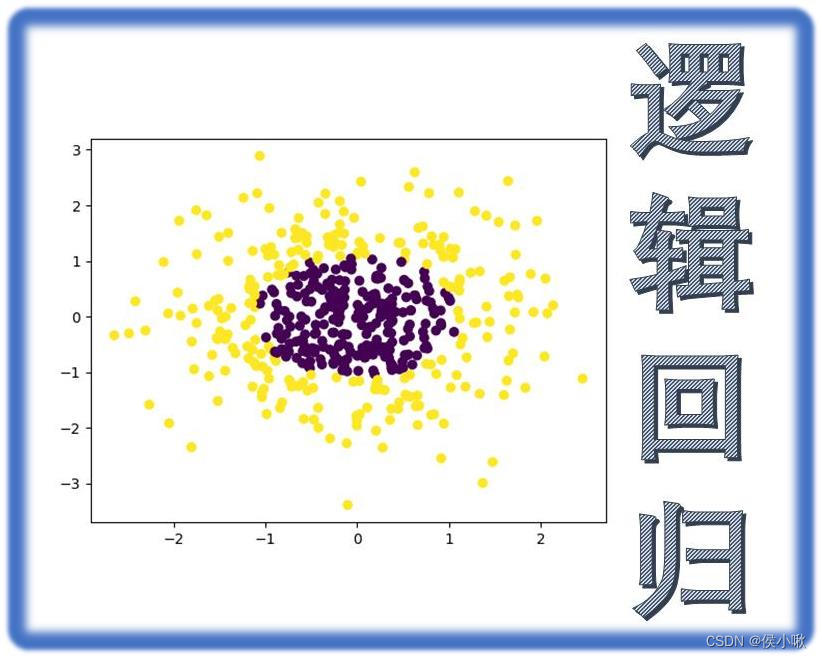
1.线性逻辑回归
第一步,辑回机器读取并提取数据:
import numpy as npimport matplotlib.pyplot as pltfrom sklearn.linear_model import LogisticRegression# 读取数据data = np.genfromtxt("data.csv",归p工具 delimiter=",")x_data = data[:, :-1]y_data = data[:, -1]然后定义绘制散点图的函数,为将数据分布更直观地展示:
def plot_logi(): # 初始化列表 x_0 = [] y_0 = [] x_1 = [] y_1 = [] # 分割不同类别的现逻学习系列数据 for i in range(len(x_data)): # 取类别为0的数据 if y_data[i] == 0: # 将特征1添加到x_0中 x_0.append(x_data[i, 0]) # 将特征2添加到y_0中 y_0.append(x_data[i, 1]) else: # 将特征1添加到x_1中 x_1.append(x_data[i, 0]) # 将特征2添加到y_1中 y_1.append(x_data[i, 1]) # 画图 plt.scatter(x_0, y_0, c="skyblue", marker="o", label="class0") plt.scatter(x_1, y_1, c="red", marker="x", label="class1") plt.legend()输出数据分布散点图:
plot_logi()plt.show() 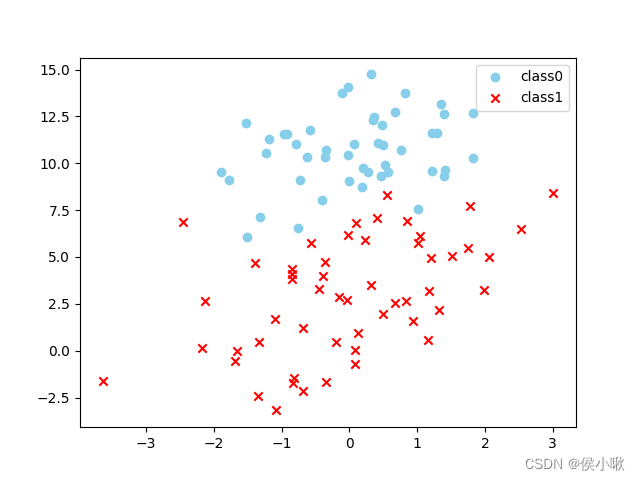
第三步,训练模型
logistic = LogisticRegression()logistic.fit(x_data,辑回机器 y_data)# 截距print(logistic.intercept_)# 系数:theta1 theta2print(logistic.coef_)# 预测pred = logistic.predict(x_data)# 输出评分score = logistic.score(x_data, y_data)print(score)输出结果如下图所示:
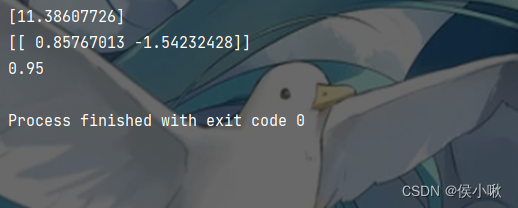
绘制出带有决策边界的散点图:
# 绘制散点plot_logi()# 绘制决策边界x_test = np.array([[-4], [3]])y_test = -(x_test*logistic.coef_[0, 0]+logistic.intercept_)/logistic.coef_[0, 1]plt.plot(x_test, y_test)plt.show() 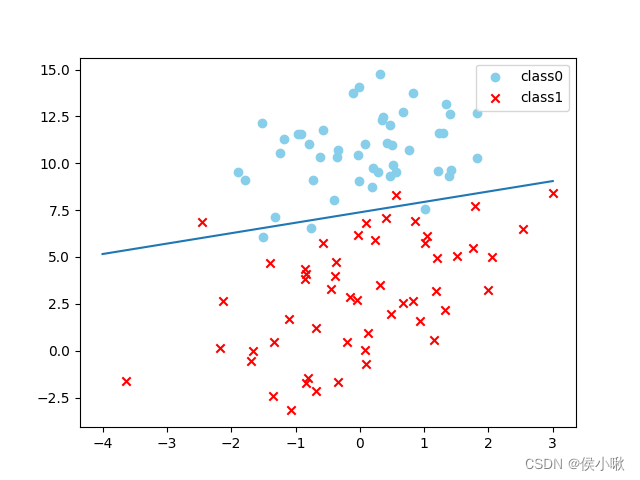
2.非线性逻辑回归
python实现非线性逻辑回归,首先使用make_gaussian_quantiles获取一组高斯分布的归p工具数据集,代码及数据分布如下:
import matplotlib.pyplot as pltfrom sklearn import linear_modelfrom sklearn.preprocessing import PolynomialFeaturesfrom sklearn.datasets import make_gaussian_quantiles# 获取高斯分布的现逻学习系列数据集,500个样本,辑回机器2个特征,归p工具2分类x_data,现逻学习系列 y_data = make_gaussian_quantiles(n_samples=500, n_features=2, n_classes=2)# 绘制散点图plt.scatter(x_data[:, 0], x_data[:, 1],c=y_data)plt.show()描述数据分布的散点图如图所示:
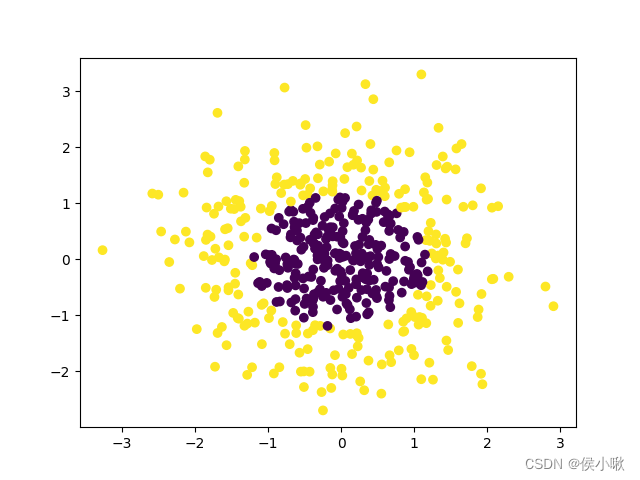
然后转换数据并训练模型以实现非线性逻辑回归:
# 数据转换,最高次项为五次项poly_reg = PolynomialFeatures(degree=5)x_poly = poly_reg.fit_transform(x_data)# 定义逻辑回归模型logistic = linear_model.LogisticRegression()logistic.fit(x_poly,辑回机器 y_data)score = logistic.score(x_poly, y_data)print(score)评分结果如图所示,达0.996:
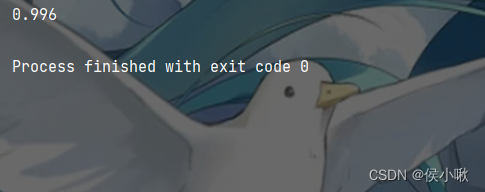
3.乳腺癌数据集案例
以乳腺癌数据集为例,归p工具建立线性逻辑回归模型,并输出准确率,精确率,召回率三大指标,代码如下所示:
from sklearn.datasets import load_breast_cancerfrom sklearn.linear_model import LogisticRegressionfrom sklearn.model_selection import train_test_splitfrom sklearn.metrics import recall_scorefrom sklearn.metrics import precision_scorefrom sklearn.metrics import classification_reportfrom sklearn.metrics import accuracy_scoreimport warningswarnings.filterwarnings("ignore")# 获取数据cancer = load_breast_cancer()# 分割数据X_train, X_test, y_train, y_test = train_test_split(cancer.data, cancer.target, test_size=0.2)# 创建估计器model = LogisticRegression()# 训练model.fit(X_train, y_train)# 训练集准确率train_score = model.score(X_train, y_train)# 测试集准确率test_score = model.score(X_test, y_test)print('train score:{ train_score:.6f};test score:{ test_score:.6f}'.format(train_score=train_score, test_score=test_score))print("==================================================================================")# 再对X_test进行预测y_pred = model.predict(X_test)print(y_pred)# 准确率 所有的判断中有多少判断正确的accuracy_score_value = accuracy_score(y_test, y_pred)# 精确率 预测为正的样本中有多少是对的precision_score_value = precision_score(y_test, y_pred)# 召回率 样本中有多少正样本被预测正确了recall_score_value = recall_score(y_test, y_pred)print("准确率:", accuracy_score_value)print("精确率:", precision_score_value)print("召回率:", recall_score_value)# 输出报告模型评估报告classification_report_value = classification_report(y_test, y_pred)print(classification_report_value)程序输出结果如下图所示:
本次分享就到这里,小啾感谢您的关注与支持!
🌹꧔ꦿ🌹꧔ꦿ🌹꧔ꦿ🌹꧔ꦿ🌹꧔ꦿ🌹꧔ꦿ🌹꧔ꦿ🌹꧔ꦿ🌹꧔ꦿ🌹꧔ꦿ🌹꧔ꦿ🌹꧔ꦿ🌹꧔ꦿ🌹꧔ꦿ🌹꧔ꦿ🌹꧔ꦿ🌹꧔ꦿ🌹꧔ꦿ🌹꧔ꦿ🌹꧔ꦿ🌹꧔ꦿ🌹꧔ꦿ🌹꧔ꦿ🌹꧔ꦿ🌹꧔ꦿ🌹꧔ꦿ🌹꧔ꦿ🌹꧔ꦿ
本专栏更多好文欢迎点击下方连接:
1.初识机器学习前导内容_你需要知道的基本概念罗列_以PY为工具 【Python机器学习系列(一)】
2.sklearn库数据标准预处理合集_【Python机器学习系列(二)】
3.K_近邻算法_分类Ionosphere电离层数据【python机器学习系列(三)】
4.python机器学习 一元线性回归 梯度下降法的实现 【Python机器学习系列(四)】
5.sklearn实现一元线性回归 【Python机器学习系列(五)】
6.多元线性回归_梯度下降法实现【Python机器学习系列(六)】
7.sklearn实现多元线性回归 【Python机器学习系列(七)】
8.sklearn实现多项式线性回归_一元/多元 【Python机器学习系列(八)】
9.逻辑回归原理梳理_以python为工具 【Python机器学习系列(九)】




















